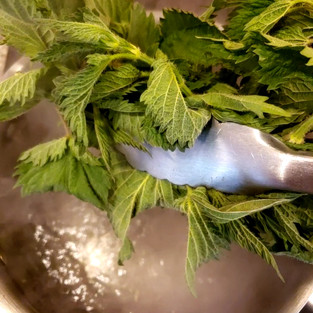Demystifying Nettles
- melissasmithers

- May 26, 2020
- 2 min read

Growing up in the Pacific Northwest, nothing said spring quite like the abundance of Stinging Nettles that would pop up in March. Like their name suggests, they do leave a tingling, aching sensation when touched. I remember my first encounter with nettles as a child, and quickly learned to identify them so as to not be stung again.
So why eat them? These beauties pack a punch when it comes to nutrients. Rich in vitamins, minerals, and antioxidants, nettles are a practically perfect post winter food.
You can harvest nettles by foraging in forests, but I recommend buying them at your local farmers market or PCC when in season (March - June). This assures that they have not been sprayed by pesticides or other chemicals. If you are going to forage them yourself, make sure you know exactly what you are looking for and wear thick gloves.
Once you have your bag of nettles at home, you are going to need to blanch them in boiling water before you do anything else. This eliminates the stinging properties and allows them to be ingested.
Bring a large pot of salted water to a boil. While waiting for the water to boil, you can set up an ice bath by putting a couple handfuls of ice cubes in a large bowl with water. Then taking tongs, blanch batches of the nettles, stems and all, in the boiling water. I like to let the water come back to a boil and then give it about another minute or two. The boiling water disarms the stinging hairs on the plant. Using to tongs remove the nettles and stir into the ice water. Repeat as necessary until all of your nettles have been blanched. Drain nettles from ice bath. Now they are ready to be used or kept in an airtight container for 2-3 days. Alternatively, you can freeze the nettles at this point or chop them up and cover them with oil for a longer refrigerator life.

So now that you have your edible nettles, what are we going to do with them?
I like to use them similar to herbs and dark leafy greens. Make them into a pesto, throw them into a frittata, chop them up with some herbs and your favorite olive oil and vinegar and pour them over meats, rice, or salad. Creamy nettle soup or making a nettle olive oil drizzle to garnish are also great ways to enjoy this wild plant!

Below: Nettle, Asparagus, and Scallion Fritatta
Above: Nettle Almond Pesto over Fresh Spinach Pasta
Nettles offer an herbaceous, wild spinach like flavor to any dish. When fresh nettles aren’t available I like to buy dried ones and steep a nutrient rich tea to drink throughout the day. The dark green elixir acts as a boost of energy and fuel for my body.
How will you enjoy these seasonal greens? You can enjoy them in this weekend's Northwest Spring dinner in the Nettle Salsa Verde.









Comments